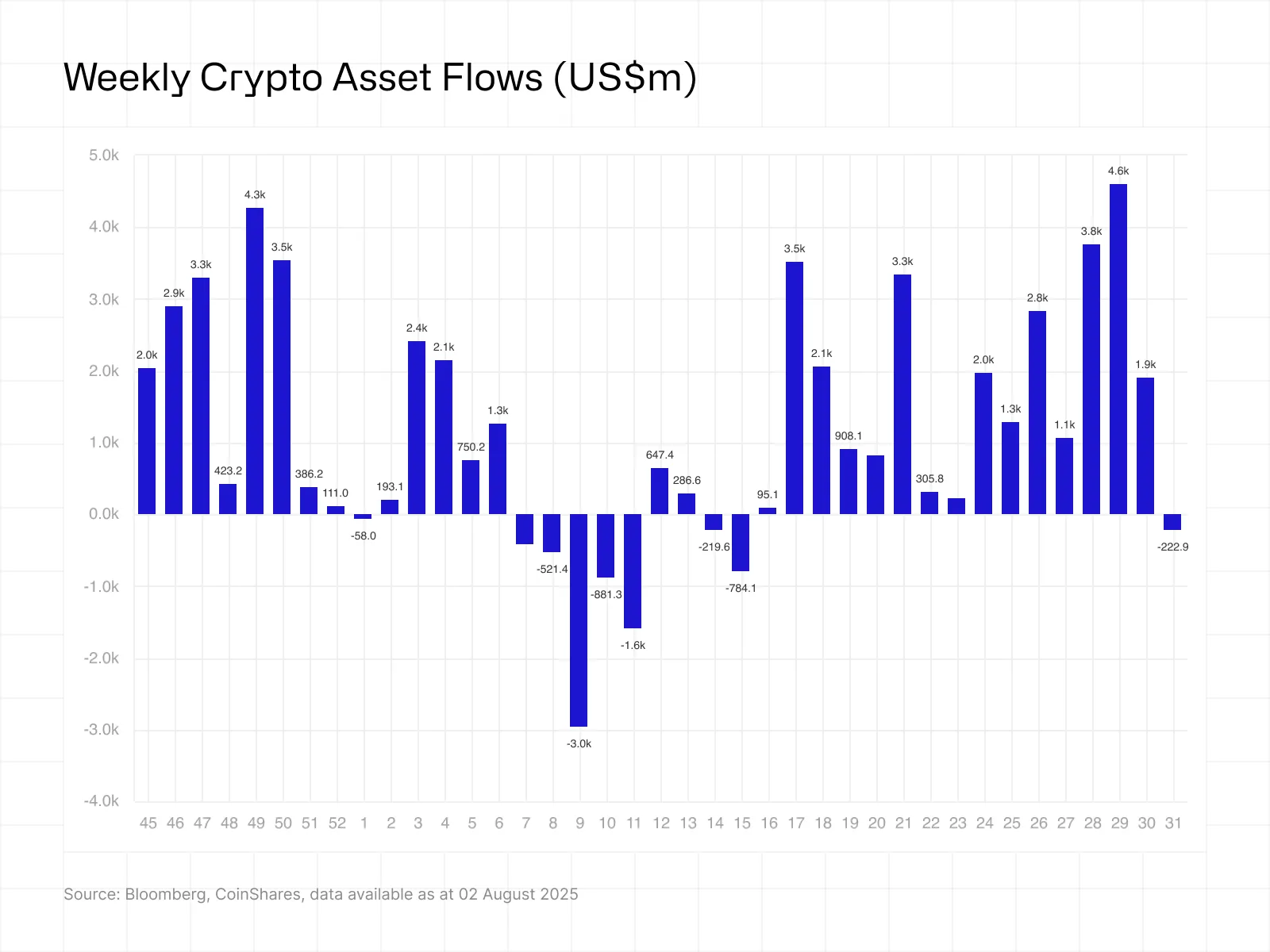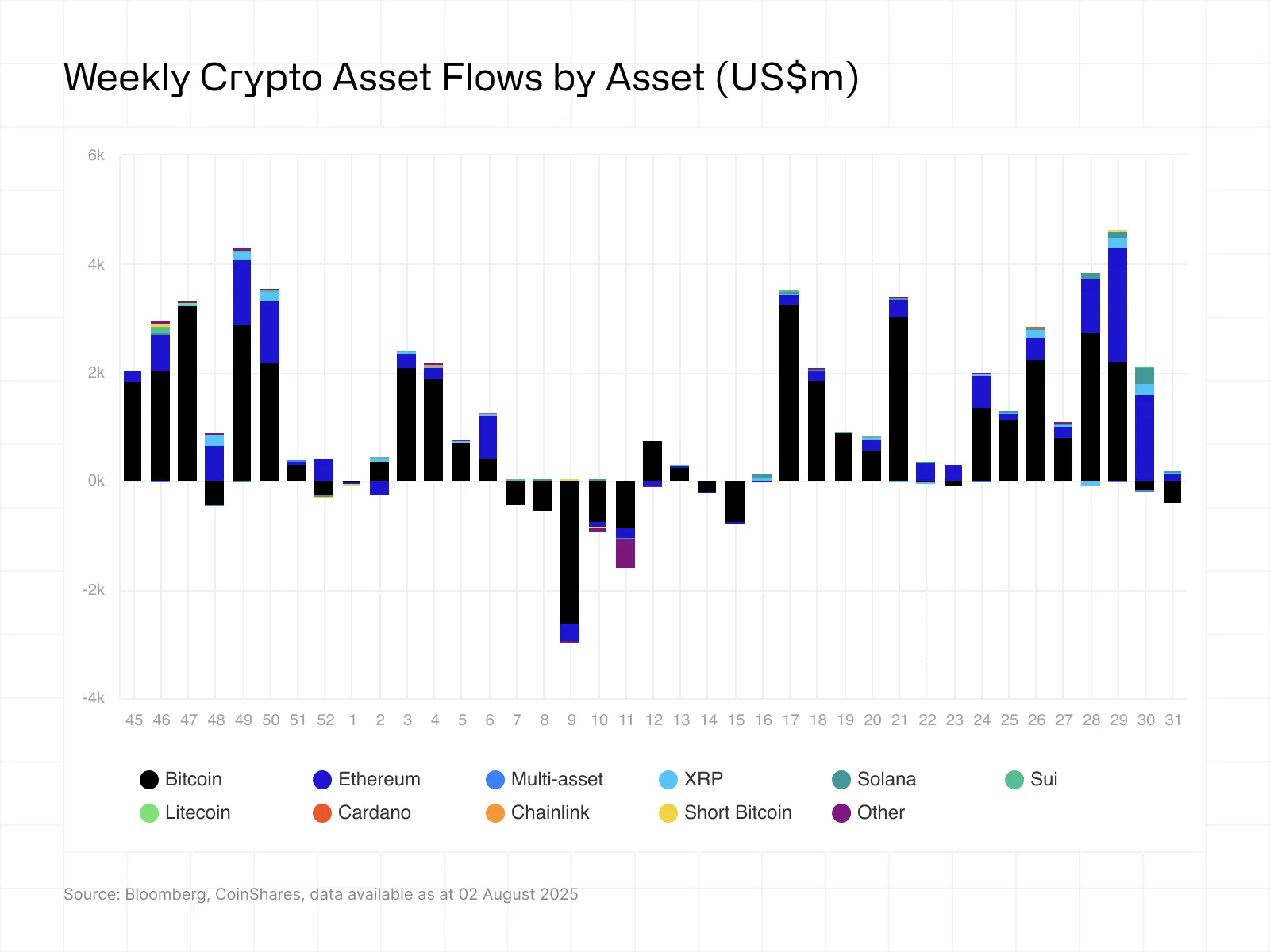Global cryptocurrency ETPs ended their 15-week winning streak last week due to profit-taking triggered by hawkish US Federal Reserve comments, with Bitcoin products seeing significant outflows while Ether funds maintained positive inflows.
-
Global crypto ETPs faced $223 million outflows last week, reversing early inflows of $883 million.
-
Bitcoin products led outflows with $404 million withdrawn amid bearish August historical trends.
-
Ether ETPs recorded their 15th consecutive week of inflows, attracting $133 million despite broader market pullbacks.
Global cryptocurrency ETPs face profit-taking after 15 weeks of inflows; Bitcoin dips while Ether remains strong. Stay informed with COINOTAG’s latest crypto insights.
Profit-Taking Interrupts 15-Week Inflow Streak in Global Crypto ETPs
Global cryptocurrency exchange-traded products (ETPs) experienced a notable reversal last week, with $223 million in outflows following a strong start of $883 million in inflows. This shift was primarily driven by hawkish remarks from the US Federal Reserve during the Federal Open Market Committee (FOMC) meeting, which dampened investor sentiment. CoinShares’ recent report highlights that after $12.2 billion in net inflows over the past 30 days, representing half of this year’s total, minor profit-taking was expected.
Bitcoin Products Lead Outflows Amid August’s Historical Weakness
Bitcoin (BTC) ETPs accounted for the majority of last week’s outflows, with $404 million withdrawn. August historically ranks as one of Bitcoin’s weakest months, with median returns of -7.49%, according to CoinGlass data. Despite this, some analysts anticipate renewed momentum post-summer, particularly when the US Congress reconvenes after Labor Day. Matrixport’s research notes that fiscal uncertainty often benefits hard assets like Bitcoin, positioning it as a key player in upcoming market narratives.

Source: CoinShares
Ether ETPs Defy Market Downturn with Continued Inflows
Contrary to the broader market retreat, Ether (ETH) ETPs sustained their positive momentum, marking the 15th consecutive week of net inflows with $133 million invested last week. This resilience is attributed to robust positive sentiment surrounding Ether, supported by ongoing institutional interest. Other altcoins such as XRP, Solana (SOL), and Sui (SUI) also saw inflows of $31.2 million, $8.8 million, and $5.8 million respectively, indicating diversified investor confidence.

Source: CoinShares
Market Impact of US Tariff Policies and Regulatory Outlook
Recent US tariff measures, including reciprocal import tariffs ranging from 15% to 41% on goods from 68 countries, initially unsettled global markets. However, cryptocurrency markets demonstrated resilience, maintaining a market capitalization above $3.7 trillion. Industry experts like Stella Zlatareva from Nexo emphasize that structural flows, institutional conviction, and the prospect of clear US regulation underpin this stability, with altcoin markets expected to regain steadiness gradually.
What Is the Impact of US Federal Reserve’s Hawkish Stance on Crypto ETPs?
The US Federal Reserve’s hawkish stance following the recent FOMC meeting has directly influenced cryptocurrency ETPs by reducing investor appetite for risk assets. This shift led to profit-taking and outflows, especially in Bitcoin products. The Fed’s comments lowered expectations for an interest rate cut in September, contributing to market volatility and a temporary pause in the inflow trend.
How Do Ether ETPs Maintain Growth Amid Market Uncertainty?
Ether ETPs continue to attract investments due to strong institutional interest and positive market sentiment. Factors such as Ethereum’s ongoing network upgrades and growing decentralized finance (DeFi) ecosystem bolster confidence. Additionally, diversified inflows into other altcoins reflect a broader investor strategy to mitigate risk while capitalizing on emerging opportunities.
Frequently Asked Questions
What caused the reversal in cryptocurrency ETP inflows last week?
Profit-taking occurred after 15 weeks of inflows, driven by hawkish Federal Reserve comments and improved US economic data, which reduced appetite for risk assets.
Is Ether outperforming Bitcoin in the current market?
Yes, Ether ETPs have consistently attracted investments, marking 15 weeks of inflows, while Bitcoin products faced significant outflows amid market uncertainty.
Key Takeaways
- Profit-taking halted 15 weeks of continuous inflows: $223 million outflows followed early-week gains.
- Bitcoin products faced the largest withdrawals: $404 million outflows amid historically weak August performance.
- Ether ETPs showed resilience: 15th week of positive inflows totaling $133 million, driven by strong sentiment.
Conclusion
Global cryptocurrency ETPs experienced a brief profit-taking phase following a prolonged inflow streak, influenced by the US Federal Reserve’s hawkish tone and economic data. While Bitcoin products saw notable outflows, Ether and select altcoins maintained investor confidence. This dynamic highlights the evolving landscape of crypto investment products and underscores the importance of monitoring macroeconomic factors and regulatory developments for future market direction.
-
Global cryptocurrency ETPs experienced a reversal in inflows after 15 consecutive weeks, impacted by hawkish US Federal Reserve comments.
-
Bitcoin products led outflows with $404 million withdrawn, reflecting August’s historically weak performance.
-
Ether ETPs maintained strong investor interest, marking their 15th consecutive week of positive inflows.
Global cryptocurrency ETPs face profit-taking after 15 weeks of inflows; Bitcoin dips while Ether remains strong. Stay informed with COINOTAG’s latest crypto insights.
Profit-Taking Interrupts 15-Week Inflow Streak in Global Crypto ETPs
Global cryptocurrency exchange-traded products (ETPs) experienced a notable reversal last week, with $223 million in outflows following a strong start of $883 million in inflows. This shift was primarily driven by hawkish remarks from the US Federal Reserve during the Federal Open Market Committee (FOMC) meeting, which dampened investor sentiment. CoinShares’ recent report highlights that after $12.2 billion in net inflows over the past 30 days, representing half of this year’s total, minor profit-taking was expected.
Bitcoin Products Lead Outflows Amid August’s Historical Weakness
Bitcoin (BTC) ETPs accounted for the majority of last week’s outflows, with $404 million withdrawn. August historically ranks as one of Bitcoin’s weakest months, with median returns of -7.49%, according to CoinGlass data. Despite this, some analysts anticipate renewed momentum post-summer, particularly when the US Congress reconvenes after Labor Day. Matrixport’s research notes that fiscal uncertainty often benefits hard assets like Bitcoin, positioning it as a key player in upcoming market narratives.

Source: CoinShares
Ether ETPs Defy Market Downturn with Continued Inflows
Contrary to the broader market retreat, Ether (ETH) ETPs sustained their positive momentum, marking the 15th consecutive week of net inflows with $133 million invested last week. This resilience is attributed to robust positive sentiment surrounding Ether, supported by ongoing institutional interest. Other altcoins such as XRP, Solana (SOL), and Sui (SUI) also saw inflows of $31.2 million, $8.8 million, and $5.8 million respectively, indicating diversified investor confidence.

Source: CoinShares
Market Impact of US Tariff Policies and Regulatory Outlook
Recent US tariff measures, including reciprocal import tariffs ranging from 15% to 41% on goods from 68 countries, initially unsettled global markets. However, cryptocurrency markets demonstrated resilience, maintaining a market capitalization above $3.7 trillion. Industry experts like Stella Zlatareva from Nexo emphasize that structural flows, institutional conviction, and the prospect of clear US regulation underpin this stability, with altcoin markets expected to regain steadiness gradually.
What Is the Impact of US Federal Reserve’s Hawkish Stance on Crypto ETPs?
The US Federal Reserve’s hawkish stance following the recent FOMC meeting has directly influenced cryptocurrency ETPs by reducing investor appetite for risk assets. This shift led to profit-taking and outflows, especially in Bitcoin products. The Fed’s comments lowered expectations for an interest rate cut in September, contributing to market volatility and a temporary pause in the inflow trend.
How Do Ether ETPs Maintain Growth Amid Market Uncertainty?
Ether ETPs continue to attract investments due to strong institutional interest and positive market sentiment. Factors such as Ethereum’s ongoing network upgrades and growing decentralized finance (DeFi) ecosystem bolster confidence. Additionally, diversified inflows into other altcoins reflect a broader investor strategy to mitigate risk while capitalizing on emerging opportunities.
Frequently Asked Questions
What caused the reversal in cryptocurrency ETP inflows last week?
Profit-taking occurred after 15 weeks of inflows, driven by hawkish Federal Reserve comments and improved US economic data, which reduced appetite for risk assets.
Is Ether outperforming Bitcoin in the current market?
Yes, Ether ETPs have consistently attracted investments, marking 15 weeks of inflows, while Bitcoin products faced significant outflows amid market uncertainty.
Key Takeaways
- Profit-taking halted 15 weeks of continuous inflows: $223 million outflows followed early-week gains.
- Bitcoin products faced the largest withdrawals: $404 million outflows amid historically weak August performance.
- Ether ETPs showed resilience: 15th week of positive inflows totaling $133 million, driven by strong sentiment.
Conclusion
Global cryptocurrency ETPs experienced a brief profit-taking phase following a prolonged inflow streak, influenced by the US Federal Reserve’s hawkish tone and economic data. While Bitcoin products saw notable outflows, Ether and select altcoins maintained investor confidence. This dynamic highlights the evolving landscape of crypto investment products and underscores the importance of monitoring macroeconomic factors and regulatory developments for future market direction.






